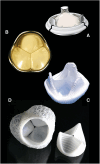Mechanical valve replacement for patients with rheumatic heart disease: the reality of INR control in Africa and beyond
- PMID: 38404722
- PMCID: PMC10884232
- DOI: 10.3389/fcvm.2024.1347838
Mechanical valve replacement for patients with rheumatic heart disease: the reality of INR control in Africa and beyond
Abstract
The majority of patients requiring heart valve replacement in low- to middle-income countries (LMICs) need it for rheumatic heart disease (RHD). While the young age of such patients largely prescribes replacement with mechanical prostheses, reliable anticoagulation management is often unattainable under the prevailing socioeconomic circumstances. Cases of patients with clotted valves presenting for emergency surgery as a consequence of poor adherence to anticoagulation control are frequent. The operative mortality rates of reoperations for thrombosed mechanical valves are several times higher than those for tissue valves, and long-term results are also disappointing. Under-anticoagulation prevails in these regions that has clearly been linked to poor international normalised ratio (INR) monitoring. In industrialised countries, safe anticoagulation is defined as >60%-70% of the time in the therapeutic range (TTR). In LMICs, the TTR has been found to be in the range of twenty to forty percent. In this study, we analysed >20,000 INR test results of 552 consecutive patients receiving a mechanical valve for RHD. Only 27% of these test results were in the therapeutic range, with the vast majority (61%) being sub-therapeutic. Interestingly, the post-operative frequency of INR tests of one every 3-4 weeks in year 1 had dropped to less than 1 per year by year 7. LMICs need to use clinical judgement and assess the probability of insufficient INR monitoring prior to uncritically applying Western guidelines predominantly based on chronological age. The process of identification of high-risk subgroups in terms of non-adherence to anticoagulation control should take into account both the adherence history of >50% of patients with RHD who were in chronic atrial fibrillation prior to surgery as well as geographic and socioeconomic circumstances.
Keywords: anticoagulation (AC); international normalised ratio (INR); low- to middle-income countries (LMICs); mechanical heart valve (MHV); rheumatic heart disease.
© 2024 Zilla, Human and Pennel.
Conflict of interest statement
The authors declare that the research was conducted in the absence of any commercial or financial relationships that could be construed as a potential conflict of interest. The reviewer TF declared a past co-authorship with the authors PH, PZ to the handling editor and confirmed the absence of any ongoing collaboration during the review.
Figures


Similar articles
-
Long-term oral anticoagulation for atrial fibrillation in low and middle income countries.Indian Heart J. 2021 Mar-Apr;73(2):244-248. doi: 10.1016/j.ihj.2021.02.003. Epub 2021 Feb 10. Indian Heart J. 2021. PMID: 33865530 Free PMC article. Review.
-
Point-of-Care International Normalized Ratio (INR) Monitoring Devices for Patients on Long-term Oral Anticoagulation Therapy: An Evidence-Based Analysis.Ont Health Technol Assess Ser. 2009;9(12):1-114. Epub 2009 Sep 1. Ont Health Technol Assess Ser. 2009. PMID: 23074516 Free PMC article.
-
Poorly suited heart valve prostheses heighten the plight of patients with rheumatic heart disease.Int J Cardiol. 2020 Nov 1;318:104-114. doi: 10.1016/j.ijcard.2020.05.073. Epub 2020 May 26. Int J Cardiol. 2020. PMID: 32464247 Review.
-
Effect of distance to health facility on the maintenance of INR therapeutic ranges in rheumatic heart disease patients from Cape Town: no evidence for an association.BMC Health Serv Res. 2015 Jun 5;15:219. doi: 10.1186/s12913-015-0890-4. BMC Health Serv Res. 2015. PMID: 26041470 Free PMC article.
-
INR self-management permits lower anticoagulation levels after mechanical heart valve replacement.Circulation. 2003 Sep 9;108 Suppl 1:II75-8. doi: 10.1161/01.cir.0000089185.80318.3f. Circulation. 2003. PMID: 12970212 Clinical Trial.
Cited by
-
Making a difference: 5 years of Cardiac Surgery Intersociety Alliance (CSIA).Asian Cardiovasc Thorac Ann. 2024 Jun;32(5):271-284. doi: 10.1177/02184923241259191. Epub 2024 Jun 13. Asian Cardiovasc Thorac Ann. 2024. PMID: 38872357 Free PMC article.
-
Recent Advances on the Prevention and Management of Rheumatic Heart Disease.Glob Heart. 2025 Feb 21;20(1):17. doi: 10.5334/gh.1402. eCollection 2025. Glob Heart. 2025. PMID: 39991593 Free PMC article. Review.
-
Making a difference: 5 years of Cardiac Surgery Intersociety Alliance (CSIA).Eur J Cardiothorac Surg. 2024 Jun 3;65(6):ezae048. doi: 10.1093/ejcts/ezae048. Eur J Cardiothorac Surg. 2024. PMID: 38856237 Free PMC article.
References
LinkOut - more resources
Full Text Sources
Medical
Research Materials
Miscellaneous

